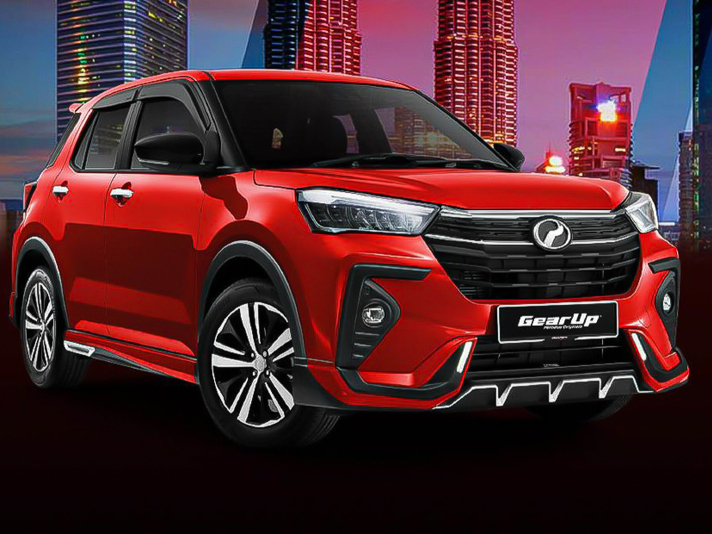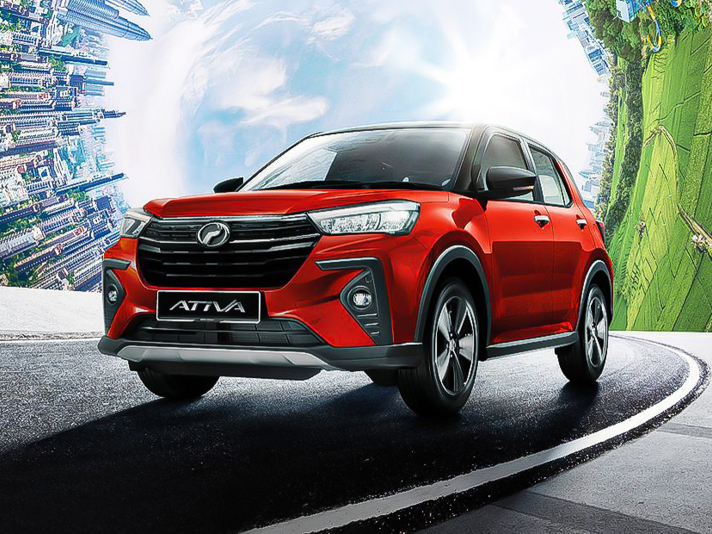Q
how much does perodua ativa cost?
When it comes to the tensile stress of a single tire on the Perodua Myvi, you'll need to check the original factory technical manual or get it measured with professional equipment for specific numbers. That's because tire stress depends on a bunch of factors like load, tire pressure, and driving conditions. Generally speaking, your average car tire has a rated tensile strength somewhere between 300-500MPa.
The Myvi, being a super popular ride in Malaysia, comes with original tires – think common setups like Bridgestone Ecopia EP150s or Goodyear Assurance – all of which meet international safety standards and can handle the mechanical stress of everyday driving.
Here's the thing though: tire stress is closely tied to maintenance. Regularly checking your tire pressure (we recommend 210kPa for the front and 200kPa for the rear when the tires are cold) and avoiding overloading can seriously stretch the life of your tires.
If you need precise data for modifications or performance calculations, your best bet is to hit up a Perodua authorized service center or the tire manufacturer directly. They'll have the specific engineering specs for your exact tire model. Also, keep an eye on the "MAX LOAD" and "MAX PRESS" numbers on the tire sidewall – they're a good indicator of how much pressure and weight the tire can handle. Stick strictly to these limits, folks, to keep yourself safe on the road.
Special Disclaimer: This content is published by users and does not represent the views or position of PCauto.
Related Q&A
Q
How long can an Ativa battery last?
The battery life of the Perodua Ativa typically ranges from 2 to 3 years, depending on usage habits and environmental factors. Malaysia's hot and humid climate can accelerate battery aging, so it's advisable to regularly check the battery status to ensure optimal performance. Key factors affecting battery lifespan include frequent short trips (which prevent full charging), usage of electronic devices, and prolonged parking. Drivers can extend battery life by avoiding excessive use of electronics when the car is parked and taking regular long drives to help fully charge the battery. It's worth noting that most modern car batteries are maintenance-free, but you should still pay attention to the battery warning light or have it professionally tested. Difficulty starting the vehicle or dimmed lights may indicate the need for a replacement. For hybrid models, the high-voltage battery system is designed to last longer, but the 12V auxiliary battery still requires similar maintenance. It's recommended to follow the original maintenance schedule and have the battery inspected and replaced at authorized service centers to ensure the stable operation of the vehicle's electrical system and to benefit from the quality assurance of genuine parts.
Q
How much is Ativa 2021 in Malaysia?
The 2021 Perodua Ativa's price in Malaysia varies by trim level. The entry-level Ativa 1.0L X starts at around RM62,500, while the higher-spec Ativa 1.0L AV goes for approximately RM72,400. Actual prices might fluctuate slightly depending on regional discounts or promotional offers. As Perodua's first SUV with a 1.0-liter turbocharged engine, the Ativa has drawn in many buyers with its fuel efficiency and sleek looks. It also comes packed with advanced safety features like the ASA 3.0 (Advanced Safety Assist) system, which includes pre-collision warning and lane keep assist. With decent ground clearance and good cargo space, this car is perfect for city driving and family use. If you're thinking about getting an Ativa, head down to your nearest Perodua dealership for a test drive to get a real feel for how it handles and check out the specs. While you're there, ask about their latest promotions—you might score some extra perks or free accessories.
Q
How many cc is Ativa?
The Perodua Ativa is a highly popular compact SUV in the Malaysian market. It is powered by a 1.0-liter three-cylinder turbocharged engine with an actual displacement of 998cc, falling into the category of small-displacement turbocharged engines. This design ensures power output while also taking fuel economy into account, making it very suitable for city driving. The Ativa has a maximum power of 98 horsepower and a peak torque of 140 Nm. Paired with a D-CVT transmission, it offers smooth power delivery and a responsive performance, which is ideal for daily commuting and family use.
It's worth mentioning that small-displacement turbocharged engines have become increasingly popular in the Malaysian market in recent years. They can provide decent power performance while reducing fuel consumption and emissions, meeting the dual demands of modern consumers for environmental protection and economy. The Ativa is also equipped with an advanced Safety Assist system, including functions such as pre-collision warning and lane-keeping assist, which further enhances driving safety.
For Malaysian consumers with a limited budget who want to enjoy the practicality and technological features of an SUV, the Ativa is a worthy option. Its cost-effectiveness and low maintenance costs are also what make it attractive.
Q
How many cylinders are in Perodua Ativa?
The Perodua Ativa is equipped with a 1.0-liter three-cylinder turbocharged engine, so it has a total of three cylinders. This engine adopts the advanced Dual VVT-i technology, which can provide good power output while taking fuel economy into account. It's very suitable for the frequent start-stop traffic conditions in Malaysian cities. The design of the three-cylinder engine is becoming more and more common in small SUVs because it can achieve high efficiency in a compact size and reduce the overall vehicle weight at the same time, which is very practical for daily commuting. The maximum power of Ativa's engine is 98 horsepower, and the peak torque is 140 N·m. It is mated with a D-CVT gearbox, and its overall performance is smooth and reliable. As a popular SUV model under Perodua, Ativa is loved by many Malaysian consumers, especially young families and urban commuters, thanks to its small and flexible body and economical fuel consumption. Although the three-cylinder engine requires higher technical requirements in noise and vibration control, the modern automotive industry has significantly improved these problems through technologies such as balance shafts to ensure driving comfort.
Q
What is the starting price of Ativa?
As one of the most popular entry - level SUVs in the Malaysian market, the starting price of the Perodua Ativa is around RM62,500 (excluding insurance). This is the base price for the 1.0L Turbo AV version. For the higher - spec 1.0L Turbo H version, the price starts from around RM72,000. The actual price may vary slightly due to dealer promotions or optional packages.
The Ativa is powered by a 1.0 - liter three - cylinder turbocharged engine, paired with a D - CVT transmission. It focuses on fuel economy, with an official fuel consumption data of 18.9 km/L. It also comes with the ASA 3.0 advanced safety assist system, including functions like pre - collision warning and lane - keeping assist. Its cost - effectiveness is quite competitive among B - segment SUVs.
It's worth noting that the Ativa is a sister model of the Japanese Daihatsu Rocky and Toyota Raize, sharing the DNGA modular platform. However, it has adjusted the suspension settings according to Malaysian road conditions and uses local parts to control costs.
When buying a car, it is recommended that consumers compare the road tax rates in different states and pay attention to the after - sales promotion packages regularly launched by Perodua, such as free maintenance times or low - interest loans. These can further reduce the cost of car ownership.
Q
Does Ativa have auto brake?
The Perodua Ativa is indeed equipped with an Autonomous Emergency Braking (AEB) system, which is part of its advanced safety assistance features. This system uses a front - mounted camera and radar to detect vehicles or pedestrians ahead. When a potential collision is detected, it automatically triggers the brakes to reduce the risk of accidents, making it particularly suitable for the complex urban traffic environment in Malaysia.
In addition to AEB, the Ativa also comes with active safety features such as Lane Keeping Assist and Adaptive Cruise Control. Overall, it has achieved a leading level of protection in its class.
It's worth noting that the Autonomous Emergency Braking system may have different technical names among different brands. For example, Toyota calls it the Pre - Collision System (PCS), while Honda refers to it as the Collision Mitigation Braking System (CMBS). However, their core functions are similar.
As a car owner, it is recommended to regularly check the cleanliness of the radar and camera to ensure the system's sensitivity. At the same time, it's important to understand that such systems are only auxiliary functions, and maintaining concentration while driving remains the primary guarantee for safety.
According to data from the Malaysian Road Safety Research Institute, vehicles equipped with AEB can reduce rear - end collisions by approximately 40%. This kind of technology is gradually becoming the mainstream configuration for new local cars.
Q
Can Ativa use CarPlay?
The Ativa is compatible with CarPlay. Some users have reported that the 2021 Perodua Ativa in Malaysia can use CarPlay. However, the data cable provided as a bonus doesn't work, causing constant disconnection. You need to use the Type-C 3.0 fast-charging data cable that comes with the original phone to avoid disconnection. Also, the overseas car infotainment system must have Easy Connect to use CarPlay.
CarPlay is an in-vehicle system launched by Apple Inc. in the United States. It seamlessly integrates users' iOS devices and iOS experience with the dashboard system. Once successfully connected, you can use the voice assistant Siri on your phone to control the in-car multimedia system. You can also operate through the touch screen on the car's dashboard or the physical buttons on the steering wheel. This makes driving operations more convenient, reduces the time drivers spend on operations while driving, and improves safety.
Q
Is Ativa 4 wheel drive?
The Perodua Ativa is a popular small SUV in the Malaysian market. However, it's not a four-wheel drive (4WD) vehicle. Instead, it uses a front-wheel drive (FWD) system. This design emphasizes fuel economy for city driving and daily practicality. The Ativa is equipped with a 1.0-liter turbocharged engine paired with a D-CVT transmission. Its power performance is suitable for city commuting. Meanwhile, its compact body size and high ground clearance also improve its passability on common road conditions in Malaysia.
For users who need four-wheel drive, they can consider other models such as the Proton X70 (some versions offer AWD) or the Toyota Rush (with an optional 4WD version). These models are more suitable for off-road or slippery roads. Four-wheel drive systems are generally divided into all-wheel drive (AWD) and part-time four-wheel drive (4WD). The former is suitable for all-weather road conditions, while the latter focuses more on off-road performance. When making a choice, you need to weigh fuel consumption, cost, and driving scenarios according to your actual needs.
In Malaysia's rainy climate, four-wheel drive models can provide better grip. However, front-wheel drive vehicles with an electronic stability system (like the ASA 3.0 standard on the Ativa) can also meet most daily needs.
Q
Is Ativa a safe car?
As a popular small SUV in the Malaysian market, the Perodua Ativa's safety performance meets the mainstream level of models in its price range. It comes standard with basic features such as dual airbags, ABS + EBD, Electronic Stability Control (ESC), and Hill Start Assist. The high - end version also adds side airbags and advanced active safety systems like Autonomous Emergency Braking (AEB) and Lane Departure Warning. Overall, its safety equipment is better than entry - level models in the same class but not as good as more premium products.
According to the ASEAN NCAP test, the Ativa received a five - star rating, with an 83% score in the adult occupant protection category. This shows that its body structure can effectively protect passengers in a collision. However, it should be noted that these tests are conducted under standard conditions, and the results in real - world road accidents may vary depending on the collision angle and speed.
For Malaysian consumers, the safety performance of the Ativa meets the needs of daily urban commuting. However, if you frequently drive long - distance on highways, it is recommended to choose a version with a more comprehensive active safety system.
It's important to note that the safety performance of any vehicle highly depends on proper use, including wearing seat belts, obeying speed limits, and regular maintenance. Good driving habits, along with maintaining an appropriate following distance and having a defensive driving mindset, can often prevent accidents more effectively than vehicle configurations.
Q
Does Ativa save fuel?
As a B-Segment SUV equipped with a 1.0-liter turbocharged engine, the Perodua Ativa really performs well in terms of fuel economy. Official data shows that its fuel consumption is about 18.9 km/l. This figure is quite fuel-efficient among vehicles in the same class, making it especially suitable for the stop-and-go traffic conditions in Malaysian cities. This is mainly due to its D-CVT transmission and engine auto start-stop technology, which can effectively reduce unnecessary fuel consumption.
If you want to further improve fuel efficiency, it is recommended to keep up with regular maintenance, use the recommended viscosity of engine oil, and avoid bad driving habits such as rapid acceleration and hard braking. Actually, apart from the vehicle's own design, driving style and road conditions also play a significant role in fuel consumption. Small SUVs like the Ativa are more flexible and fuel-efficient for urban commuting than large SUVs. However, if you often drive long distances on highways, the fuel consumption advantage may not be as obvious.
In addition, the proper use of air conditioning in Malaysia's hot weather can also affect fuel consumption. It is recommended to set the temperature between 23 - 25 degrees Celsius to achieve energy-saving results.
Popular Cars
Model Year
Car Compare
Car Photo
Latest Q&A
Q
How powerful is 2 horsepower?
2 horsepower converts to approximately 1491.4 watts (or 1.4914 kilowatts) in the International System of Units. From a practical experience perspective, 1 horsepower is equivalent to the power output required to carry a 10-kilogram load and run 100 meters in 13 seconds. Therefore, the intensity of 2 horsepower is about twice that level—for example, it can carry a 20-kilogram load to complete 100 meters in 13 seconds, or carry a 10-kilogram load to finish the distance in a shorter time. In daily application scenarios, 2 horsepower falls into a relatively small power range, far lower than the typical 100-200 horsepower output of a family car engine. It is commonly found in small mechanical equipment such as some garden pruning tools, small water pumps, or lightweight agricultural auxiliary machinery, which need to continuously output small power to complete specific tasks. It should be noted that there are distinctions between imperial horsepower and metric horsepower, but the imperial horsepower conversion standard is usually adopted by default in daily use.
Q
What is the lifespan of a 2HP motor?
The lifespan of a 2HP motor is influenced by multiple factors such as usage frequency, maintenance practices, operating environment, and motor type. When used correctly under rated conditions and maintained regularly, its average lifespan typically ranges from 10 to 15 years. However, if it operates for a long time in high-temperature, humid, or dusty environments, or runs under frequent overload, its lifespan may be shortened to 5 to 8 years. In practical application scenarios in Malaysia, such as small pumps for automotive auxiliary systems or small industrial drive motors (if they are of 2HP specification), choosing high-quality brand products and following standardized maintenance procedures (such as regular cleaning, checking lubrication, and electrical connections) can effectively extend the service life. Additionally, the manufacturing process and material quality of the motor also affect its lifespan, and products from reputable brands usually have better durability guarantees. It should be noted that timely replacement of worn parts and avoiding long-term continuous overload operation are key measures to maintain the motor in good condition.
Q
How fast does 2 hp go?
The speed corresponding to 2 horsepower varies depending on the vehicle type and design. Taking electric two-wheelers as an example, 1 horsepower is approximately equal to 0.7457 kilowatts. Referring to relevant model data, an electric two-wheeler equipped with a motor of about 2 kilowatts (approximately 2.68 horsepower) can reach a maximum speed of 62 km/h. Therefore, a vehicle with 2 horsepower has a speed roughly ranging from 55 to 60 km/h.
Such vehicles are typically suitable for short-distance urban commuting scenarios. Some models also feature two riding modes: economy and sport. The full-charge range can reach 105 km, and charging from 0 to 80% takes approximately 6 hours. They also come with a 2-year or 20,000-kilometer warranty. Some models may qualify for subsidies under local policies, further improving commuting cost-effectiveness. The design of these vehicles meets urban transportation needs while balancing practicality and convenience.
Q
How many kW are in 2HP?
The result of converting 2HP to kilowatts (kW) varies slightly depending on the type of horsepower: if it is British mechanical horsepower (commonly used in automotive and other fields), 2HP is approximately equal to 1.49kW (accurate value is approximately 1.4914 kW); If it is metric horsepower (also known as horsepower), 2HP is approximately equal to 1.47kW (accurate value is approximately 1.471kW). In practical applications, such as engine power labeling or motor parameters, approximate values are sometimes used to simplify 2HP to 1.5kW for quick reference. Horsepower (HP) and kilowatts (kW) are both units of power. The former originated from measuring mechanical power (such as steam engines and horse pulling force), while the latter is an internationally recognized unit of power standard. The conversion relationship between the two needs to be determined according to specific definitions, and the choice in different scenarios will affect the final conversion result.
Q
What is the power of a 2 hp motor?
The power of a 2 hp motor can be derived through the conversion between horsepower and the international standard unit of power. HP, or horsepower, has two common standards: imperial and metric. 1 imperial HP is approximately equal to 745.7 watts, while 1 metric HP is about 735 watts. When converted using the metric standard, the power of a 2 hp motor is 2 × 735 = 1470 watts (i.e., 1.47 kilowatts); when using the imperial standard, it is approximately 2 × 745.7 ≈ 1491.4 watts (around 1.49 kilowatts). In practical applications, different standards may be adopted in different scenarios, but a common approximation in the industry is that 2 hp is roughly equal to 1.5 kilowatts. Horsepower is a traditional unit of power, often used to describe the output capacity of equipment such as motors and engines. However, in the International System of Units, watts or kilowatts are more recommended as units of power. Therefore, in formal technical documents, horsepower values are usually converted to watts or kilowatts for labeling to ensure the uniformity and accuracy of technical communication. Mastering such unit conversion relationships helps to accurately understand the power output capacity of motors in scenarios such as equipment selection and performance evaluation.
View MoreRelated News

Perodua Traz VS Ativa, which one is more worth buying?
AshleyDec 23, 2025

Perodua Ativa review: A B-Segment SUV with outstanding value for money
AshleyJul 21, 2025

Perodua Ativa interior design revealed: One of Malaysia's most popular urban SUVs
JamesJul 14, 2025

Perodua Ativa: Why Malaysia's Top Compact SUV?
MichaelJun 12, 2025

The Comprehensive Introduction of the Perodua Ativa: A Must-Read Before Buying
RobertMar 25, 2025
View More


















Pros
Cons